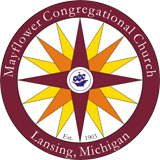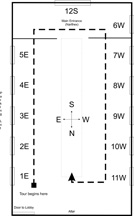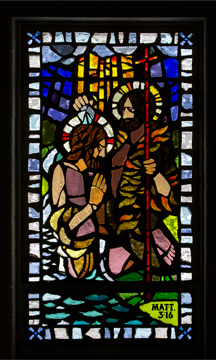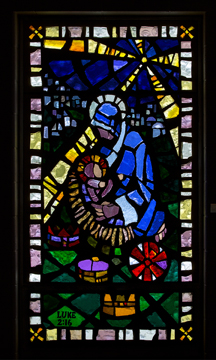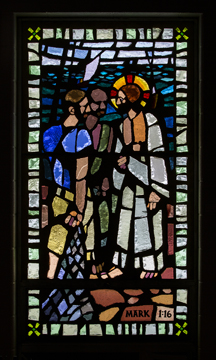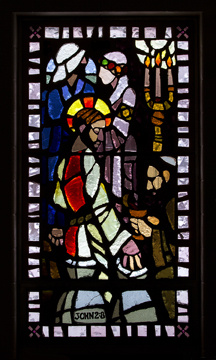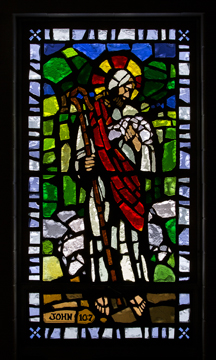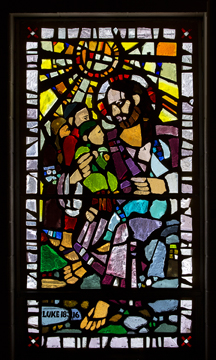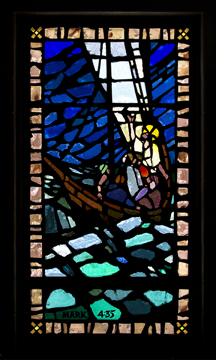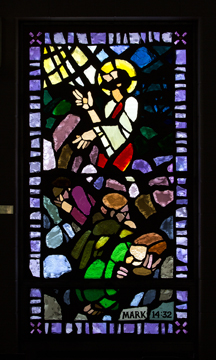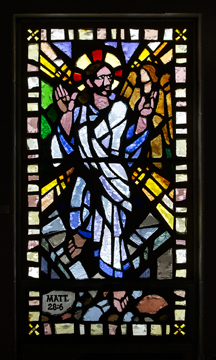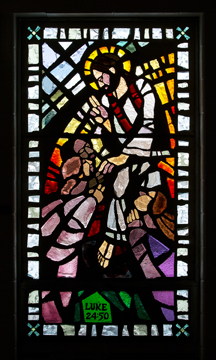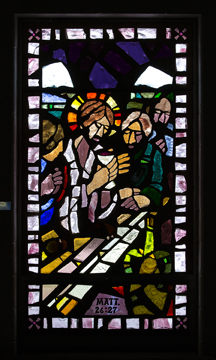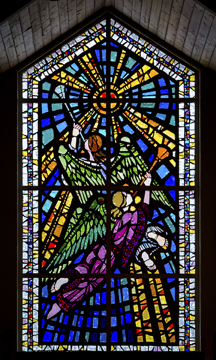The windows themselves tell our story: the story of our Christian faith and the life of the One upon whom our faith is built: Jesus, the Christ. This web page is prepared from information shared during the worship services in late 1996 in celebration of the twentieth anniversary of the dedication of the last window. The services and sermons were planned around the theme of the window, with one window being showcased each week. This booklet contains only the information about the windows and not the liturgy or sermons. On February 23, 1975, the Stained Glass Window Committee met for the first time. It was composed of Orlin Bender, Velva Ellis, Irene Hurla, Judy Scribner, Les Switzer, and Gene VanVoorhis. They discussed several ideas at that meeting, including substitutes for “old-fashioned” leaded glass windows. It was suggested that the windows be installed one each year so that they would be more appreciated. It was especially noted in the minutes that one of the suggested artists was a woman! The committee felt that the sanctuary needed a new paint color to enhance the windows, but decided to wait a while before bringing up the subject with the Advisory Council. The committee toured other churches to look at their stained glass windows. A number of themes were discussed. Finally, the committee recommended and the congregation accepted the plan to use the 'faceted' or 'Dalle de Verre' style of stained glass for a more contemporary look. At that time there were 1500 different colors of facet glass available. Omnibus Ideas in Okemos, Michigan, was chosen as the source and artists Richard Hanley and Mark Taleba created the designs which are based on the Life of Christ. The windows were constructed in a facility in Detroit. The original plan included the ten windows in the sanctuary; the windows in the narthex were added later in the process. Each window was donated by members of the congregation. When the windows were installed, identifying plaques were discussed, with options including silver, brass, and plastic. At first, the committee chose brass with black engraving because they considered it the most attractive. At a later meeting they decided instead to use brown plastic with white letters because they would be easier to read. In 1996, they were replaced by the brass plaques now in use. The plaques in the narthex were added to match the others. The windows are approximately 45" wide by 80" tall, except for the large window, Jubilate Deo, which measures approximately 8 feet wide by 17 feet tall. It is important to note that t he windows are shown and described according to their placement in the sanctuary rather than in order of construction and dedication (noted at the end), or chronological order of the events they depict. This is in order to take the "walking tour" in person with the accompanying booklet, and/or to facilitate visualization for this digital "virtual tour." Walking Tour - The tour begins in the Northeast corner of the sanctuary (entering from the office lobby door) and will continue around the sanctuary in a clockwise direction. Booklets to accompany this tour may be obtained in the lobby (or church office).
This window is based on Matthew 3:16. It depicts the Baptism of Jesus by John the Baptist (or the Baptizer, as some call him) in the Jordan River. John is kneeling on the bank as Jesus stands hip-deep in the waters of the Jordan River. John uses a shell to pour water on the head of Jesus. This is a classic depiction of this event. In the early Middle Ages, a shell was used to pour the baptismal waters on the head of the one being baptized, and the shell became a symbol of Christian baptism. Around the heads of both John and Jesus is a nimbus, or halo. This is also a classic element and represents holiness. John holds a staff topped by a cross. The Baptism was the beginning of the earthly ministry of Jesus, and the cross was to be the end. A stylized dove descends upon Jesus, representing the power of God coming upon Jesus for the work of his ministry. The scripture account mentions both the dove and a voice from heaven.
The design is a contemporary version of the Madonna and Child. Against a purple background, the golden Christmas Star shines down upon the Mother and Baby. In the foreground are the three gifts of the Magi: gold, frankincense, and myrrh. The gold symbolizes the royalty and majesty of the Baby as the descendant of David, the King. Frankincense is for use in worshipping God. Myrrh was a burial spice and represents the coming death of Christ. In the lower right foreground is a red symbol composed of the two Greek letters Chi (X) and Rho (P) superimposed and enclosed in a circle. These two letters are the first letters in the Greek word Christos (meaning “the anointed” or “the chosen”), from which we get the word Christ. In each corner is a gold form which looks like an “X”. This might be another Chi or a St. Andrew’s cross. An early legend says that Andrew, one of the twelve disciples, was crucified on a cross with this configuration. Both symbols became symbols for Christ very early in church history. The colors associated with Mary predominate in this window: white, gold, silver, and blue. White symbolizes holiness; gold (and the purple of the star and the gifts) represents majesty; silver and blue represent purity.
This window also has in each corner what looks like the letter “X”—the Greek letter Chi, which is the first letter of the word Christos from which we get the word Christ. Again in this window, artists have given us a contemporary rendition of a traditional theme, including some of the classical elements in the design. This window shows Jesus’ calling of the first disciples: Andrew and his brother Simon Peter. The following verses mention the calling also of the sons of Zebedee, James and John (sometimes called the “sons of thunder”!). The setting is the shore of the very large lake sometimes called Lake Gennesaret and better known as the Sea of Galilee. In the background, a fishing boat sails in the blue waters of the lake. A second boat, which may be anchored at the shore, is just visible over the left shoulder of Jesus. In the foreground, we see Jesus with the nimbus or halo that became an element of religious art during the Middle Ages. Jesus is talking to two men, Simon (better known as Peter) and his brother Andrew. Andrew is holding a fishing net, which is one of his attributes or one of the elements used in classic religious art to identify him. According to the scripture text, Jesus is asking the brothers to make a life-changing decision: to leave their former lives and livelihoods and to become Jesus’ disciples.
This is the story of Jesus’ first public miracle: changing water into wine for the wedding feast. In the foreground are two of the stone water jars which Jesus had the servants fill. Jesus is in the center with his right hand resting on the top of one of the jars. A servant pours wine into a chalice. Behind Jesus stand the bridegroom and the bride. Early tradition identified them as John the Apostle (who was perhaps a cousin to Jesus) and Mary Magdalene. The presence of Jesus at the feast signifies his blessing of the institution of marriage. During the Middle Ages, it was taught that this story showed the superiority of Christianity over Judaism, in that the water of Judaism was changed into the wine of the Gospel. The three-pronged candelabrum is styled after the description of the candlesticks in the Tabernacle and in the Temple. Those candlesticks had seven branches, representing the Seven Spirits of God (also seen in the vision of John written in the Revelation). The three branches here may represent the Holy Trinity.
The window shows Jesus as the Good Shepherd, one of the traditional and classic descriptions of Christ. Jesus stands at the center of the window, holding a shepherd’s crook in one hand and carrying a lamb across his shoulder. He looks gently at the lamb. This image of Jesus as Shepherd with the believers as his lambs was so prevalent in the early church that it gave rise to the language describing pastors and bishops as under-shepherds to the Lord’s flock. The shepherd’s crook became the bishop’s crozier, a staff signifying the office and role of overseer. There are many other references to shepherds in the scriptures. Shepherds near Bethlehem were told by angels of the birth of the Christ Child. David, the great King of Israel, was a shepherd watching his father’s sheep when Samuel anointed him to be king. David is traditionally considered to be the author of many Psalms, including the Shepherd’s Psalm (Psalm 23). Abraham, the father of Israel, had many herds and flocks as did his sons Isaac and Jacob. The prophet Amos was a shepherd in Tekoa, and many prophetic writings use the imagery of sheep and shepherds.
Even though this window was not a part of the original plan, it certainly fits very comfortably into the theme of the Life of Christ presented in the windows. It is a little difficult to imagine the series without it, since Jesus blessing the children is so much a part of our concept of the life and ministry of Jesus. As with the other windows, this is a contemporary rendering of a classic subject: Jesus with the children. It shows Jesus wearing a robe in shades of purple seated on a rock with the classic nimbus (halo) around his head. Two children, a boy dressed in green robe and yarmulke and a girl dressed in a blue robe and head covering, sit on his lap with his arms encircling them. Very, very close to these two children and very, very close to Jesus stand two other children: a girl in a deep brownish-purple robe and a boy in a red robe. Behind and above and illuminating this scene is a sunburst in shades of yellow, gold, and orange. This window especially shows the unusual and beautiful qualities of the facet glass technique as opposed to the traditional leaded glass as well as the skill of the artist in the use of shaded pieces of glass. The thickness of the glass and the shapes of the pieces are used very skillfully to shape and shade the figures of Christ and the children and the sunburst. The artist's skill is evident in the detail of the figures of Christ and of the children, and particularly in the detail in the face and the eye of Jesus as he looks at the children. The colors and the detail work show to great advantage the special qualities of the facet glass. There are some unusual and vivid colors used in this window: the greys in the rock, the shades of purple in Jesus’ robe, the red robe and the yarmulke of the standing boy, the shades of yellow in the sunburst, the deep purple (almost brown) in the robe of the standing girl, the deep brown of Jesus’ hair. Some of them are used in other windows in the sanctuary, but they are especially noticeable in this one, perhaps because of the combinations used.
This window also uses shadings of color to advantage—especially in the water and the sky. Shades of blue-green represent the water. Darker shades indicate the waves of the storm. In the blue of the sky, darker shades are also used to indicate the storm clouds and winds. The angle of the boat indicates rough water. The sail of the little ship projects out of the top of the window. In the boat Jesus stands with his right hand lifted to Heaven as he commands the storm to be still. At his feet are four disciples huddled in the bottom of the boat, seeking safety. This window is one of the most nearly monochromatic of the window series. Most of the colors are very closely related. It depends upon shading for the impact of the story portrayed. On November 6, 1975, while installing one section of the window, a workman fell and the section was broken. The workman was not injured seriously. The section was redone, and the window was installed February 27, 1976, and dedicated March 7, 1976. This window was donated by the Women’s Fellowship in memory of all who served the church and especially in memory of those members who have done so much for the benefit of the church.
It shows Jesus kneeling in prayer beside a rock. In the foreground Peter, James, and John are sleeping while Jesus anguishes in prayer over the events soon to befall him. Light from Heaven streams down and touches his face as he prays, “If it is possible, let this cup pass from me. Yet not my will but thine be done.” The synoptic Gospels (Matthew, Mark, and Luke) tell us that after the Last Supper, Jesus and the disciples (except for Judas Iscariot) went out to the Mount of Olives. Gethsemane means “olive press,” and so it is likely that the Garden was on or near the Mount of Olives (also known as Mount Olivet). There, Jesus left eight of the disciples and took with him the three who formed the inner circle: Peter, James, and John, and went further into the garden. He asked them to remain awake and wait with him, and went a little farther into the garden to pray. Three times he came back and found them asleep. “Could you not watch with me one hour? The spirit is willing but the flesh is weak.” The third time he awakened them and said, “My betrayer is at hand.” The soldiers led by Judas Iscariot arrived to arrest Jesus. The artist has chosen deep colors for this window, emphasizing the seriousness and the import of the event. It was in this experience of prayer in the Garden that Jesus finally and totally committed himself to see through to completion the events to come: his arrest, trials, and crucifixion. Many theologians have argued that it was in the Garden that the battle for human salvation was won. After the prayer of Jesus: “Thy will and not mine be done,” all else was settled and inevitable. It was in this prayer that Jesus found strength to face the coming trials and torture, knowing that despite all appearances, God was in control.
This window also has in all four corners the Greek letter Chi (X). Very early in church history, this became a symbol for Christ. This figure is repeated in the beams of light or glory streaming from the Risen Christ in the foreground. The figure of the Risen Christ is the central image in this window in shades of blue and white. These colors represent purity and holiness. Streams of light or glory are shown in yellows and golds. In the upper foreground is an angel shown in shades of gold. Presumably, this is the angel who spoke the words of the Scripture passage (Matthew 28:6): “He is not here, for he has been raised as he said. . .” Undoubtedly, this event is the very heart of the Christian message and the foundation of the Church.
It shows the Ascension of Jesus into Heaven. After his Resurrection, Jesus spent forty days with the disciples teaching them and explaining to them his mission and the commission he would leave them. Then he led them from Jerusalem to Bethany. There, he gave them instructions to wait in the city for the coming of the Holy Spirit, blessed them, and ascended into Heaven. In this window, the artist shows Jesus, dressed in white (representing purity and holiness) with what appears to be a red stole around his neck (red represents the Holy Spirit whom Jesus promised would come). His right hand is raised in blessing or benediction with the thumb and first two fingers extended—what came to be the traditional sign of blessing in the Western Church. The fingers and thumb symbolize the Holy Trinity. With his left hand, Jesus reaches to the three disciples gathered near him in a gesture of comfort. The three disciples reach toward Jesus as if to hold onto him. Behind the Risen Christ is an arc of red-orange, gold, and yellow. The shape of the arc might remind us of the rainbow and God’s covenant with Noah, leading us to think of God’s New Covenant with humankind through Jesus Christ. The colors suggest the glory of Heaven into which Christ disappeared.
The original plan was that this window would reflect a theme related to music, but after the decision was made to have all of the windows depict an event in the Life of Christ, it was changed to The Last Supper to maintain continuity. In this window the artist depicts The Last Supper which Jesus shared with his disciples. According to the Gospels, this was the Passover Seder celebrating the deliverance of the Israelites from slavery in Egypt and their exodus into the wilderness. Jesus is in the center holding a chalice: “. . . my blood of the new covenant poured out for you and for many for the forgiveness of sins. . .”. On the table are two broken loaves of bread: “. . . this is my body given for you. . .”. On his left are two disciples and one is shown on his right. The one sitting closest to Jesus, according to tradition, is John the Beloved Disciple. In the background, two windows open onto the surrounding countryside and we can see on the horizon the hills which surround the city of Jerusalem. Through the left window, we can see water which is probably the Dead Sea, located about 20 miles east of Jerusalem. The Mediterranean Sea is over 50 miles to the west, and it is unlikely that it could be seen even from the Upper Room. This would mean that Jesus is facing west. When Christianity became an accepted religion and began to construct places of worship, churches were built so that the worshipers faced east—toward Jerusalem—and the priest would be facing west as Jesus is in this picture. One of our favorite communion hymns remembers this tradition in the words, “When I fall on my knees with my face to the rising sun. . .”. According to the Holy Scriptures, Jesus instructed the disciples to continue the Supper in remembrance of him. After the Supper, Jesus and the disciples went out to the Mount of Olives to the Garden of Gethsemane, where he was betrayed by Judas Iscariot.
It was financed partially by transferring the money collected by the Sunday School for the window showing Jesus and the Children (which was paid for by another donor). The remainder of the money was raised by people donating the cost of one or more pieces of glass at $7.05 a piece. Their names were recorded in a book of donors. There are 850 pieces of facet glass in this window. This means that the cost of the window was $5992.50—in 1976. The window shows two angels flying toward a sunburst. Each angel has a trumpet. The window is based on Psalm 100: “Make a joyful noise unto the Lord. . .”, and its title, Jubilate Deo, means “Glory to God.” The plaque for this window was added in 1996. At one time, there were future plans to replace the clear glass in the small door windows with stained glass. It was decided that this would not be wise since the ushers used these windows to watch for people arriving in order to open the doors and help them enter. Order of Installation and Dedication Installed Nov. 20, 1975, and dedicated Nov. 23, 1975:
Installed Feb. 27, 1976, and dedicated Mar. 7, 1976:
Installed May 28, 1976, and dedicated June 6, 1976:
Installed Aug. 4, 1976, and dedicated Sept. 19, 1976:
Dates Uncertain:
This litany was used in the dedication services for all of the windows. It is taken from O Light Divine, We Praise Thee by T. S. Eliot. Leader: We thank thee for the lights we have kindled, the light of altar and of sanctuary; People: small lights of those who meditate at midnight, and lights directed through the colored panes of windows, Leader: and light reflected from the polished stone, the gilded carven wood, the colored fresco. People: Our gaze is submarine, Leader: our eyes look upward and see the light that fractures through unquiet water. People: We see the light but see not whence it comes. Leader: O Light Invisible, we glorify thee! People: In our rhythm of earthly life we tire of light. Leader: We are glad when the day ends, when the play ends; and ecstasy is too much pain. People: We are children quickly tired; children who are up in the night and fall asleep as the rocket is fired; and the day is long for work or play. Leader: We tire of distraction or concentration. We sleep and are glad to sleep; controlled by the rhythm of the blood and the day and the night and the seasons. People: And we must extinguish the candle—put out the light and relight it; Leader: forever must quench, forever relight the flame. People: Therefore we thank thee for our little light that is dappled with shadow. Leader: We thank thee who has moved us to building, to finding, to forming at the ends of our fingers and the beams of our eyes. People: And when we have built an altar to the invisible light, we may set thereon the little lights for which our bodily vision is made. Leader: And we thank thee that darkness reminds us of light. ALL: O Light Invisible, we give thee thanks for thy great glory!
|
|
| Mayflower Church - Come grow with us!
|
